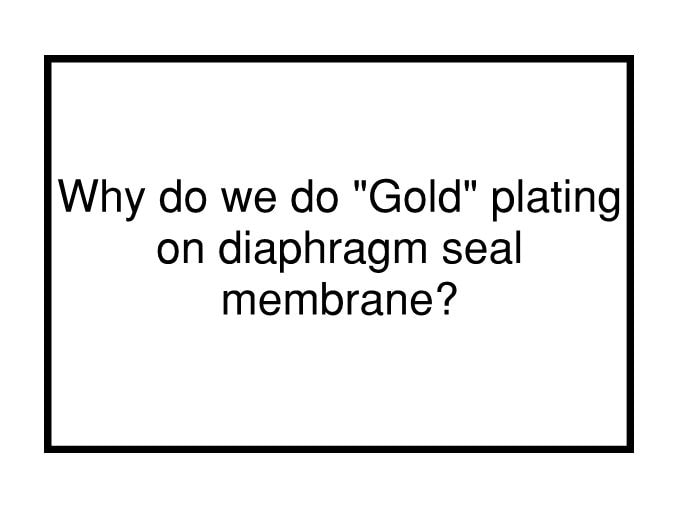Gold Plating on Diaphragm Seal membrane
When do diaphragm seal membrane usually require Gold plating ?
We usually go for gold plating on diagram seal assembly when we have Hydrogen service with pressure greater than 6 BARG.
API RP 551 recommends the same for further more scenarios as follows :-
1. For a transmitter temperature ≥43 °C (110 °F) when any hydrogen is present
2. Wet hydrogen service
3.With Pressure greater than 90 PSIA (5 BARG)
Why to go for gold plating of diaphragm seal ?
This is due to phenomenon of Hydrogen permeation.
In simple words hydrogen is very miniscule in size, thus it tends to permeate through the Diaphragm seal membrane.
Hence hydrogen embrittlement weakens it and also enters the fill-fluid of diaphragm seal causing errors.
We usually go for gold plating on diagram seal assembly when we have Hydrogen service with pressure greater than 6 BARG.
API RP 551 recommends the same for further more scenarios as follows :-
1. For a transmitter temperature ≥43 °C (110 °F) when any hydrogen is present
2. Wet hydrogen service
3.With Pressure greater than 90 PSIA (5 BARG)
Why to go for gold plating of diaphragm seal ?
This is due to phenomenon of Hydrogen permeation.
In simple words hydrogen is very miniscule in size, thus it tends to permeate through the Diaphragm seal membrane.
Hence hydrogen embrittlement weakens it and also enters the fill-fluid of diaphragm seal causing errors.
Why is this criteria of 6 Barg of Pressure ?
Hydrogen in environmental condition exists as H2 molecule, but at high pressure this bond breaks and high pressure causes them to temporarily split.
These small H+ atoms now being so minuscule in size, permeate through the diaphragm membrane.
Once they permeate through other side of the diaphragm seal there isn’t such high pressure so these molecules combine and thus remain trapped inside the assembly.
Gold plating thickness ?
As a rule of thumb 40µm thickness is preferred for Diaphragm seal membrane.
Thickness for gold coating of transmitter’s membrane in hydrogen service (without diaphragm seal) is usually preferred as 25µm.
Note that there is “no fixed guide” to stick with a particular thickness, for Instance API 551 RP emphasizes more on the quality of coating than just the thickness, sometimes client design preference dictate the thickness required.(reference API 551 Section 3.6.6 page 16)
Base membrane material for Gold coating ?
Stainless Steel is usually the least affected material and is the most preferred with regards to base material.
It is said that Hastelloy C276 material is not be used as base material for gold coating of diaphragm seal but unfortunately such a statement was not found in the few major standards of diaphragm seal like ASME B40 or API 551 RP etc.
Personally, I have done a project where a reputed vendor did provide Gold plating on Hastelloy Base material.
But regardless, I would suggest if such a situation arises then it is advisable to consult with Material engineer before deriving to a conclusion.
API explicitly states that tantalum is very prone to Hydrogen embrittlement and recommends that it should not be used as base material.
Also beware that in worst case scenario if the Gold plating fails, the membrane material will come in contact with process hence it must be given due consideration.
Miscellaneous precautions
In a diaphragm seal assembly besides diaphragm membrane there are also other parts that come in contact with process (Wetted parts).Like Flushing ring, Flushing Flange, Plugs, Isolation valves, gaskets etc.
Due care must be taken during their selection as well.
The most preferred choice of material for these wetted parts is stainless steel as it is one of the least affected material with regards to hydrogen embrittlement.
Hope this has been of value to you.
Thanks for reading.
PS: This is as per best of my current understanding.
To receive such engineering post and relevant job opening “once” every alternate weekend you could jump in to the free newsletter below.
Please note this Newsletter is truly free not just from monetary point of view but also free from any spams or advertisements.
Hydrogen in environmental condition exists as H2 molecule, but at high pressure this bond breaks and high pressure causes them to temporarily split.
These small H+ atoms now being so minuscule in size, permeate through the diaphragm membrane.
Once they permeate through other side of the diaphragm seal there isn’t such high pressure so these molecules combine and thus remain trapped inside the assembly.
Gold plating thickness ?
As a rule of thumb 40µm thickness is preferred for Diaphragm seal membrane.
Thickness for gold coating of transmitter’s membrane in hydrogen service (without diaphragm seal) is usually preferred as 25µm.
Note that there is “no fixed guide” to stick with a particular thickness, for Instance API 551 RP emphasizes more on the quality of coating than just the thickness, sometimes client design preference dictate the thickness required.(reference API 551 Section 3.6.6 page 16)
Base membrane material for Gold coating ?
Stainless Steel is usually the least affected material and is the most preferred with regards to base material.
It is said that Hastelloy C276 material is not be used as base material for gold coating of diaphragm seal but unfortunately such a statement was not found in the few major standards of diaphragm seal like ASME B40 or API 551 RP etc.
Personally, I have done a project where a reputed vendor did provide Gold plating on Hastelloy Base material.
But regardless, I would suggest if such a situation arises then it is advisable to consult with Material engineer before deriving to a conclusion.
API explicitly states that tantalum is very prone to Hydrogen embrittlement and recommends that it should not be used as base material.
Also beware that in worst case scenario if the Gold plating fails, the membrane material will come in contact with process hence it must be given due consideration.
Miscellaneous precautions
In a diaphragm seal assembly besides diaphragm membrane there are also other parts that come in contact with process (Wetted parts).Like Flushing ring, Flushing Flange, Plugs, Isolation valves, gaskets etc.
Due care must be taken during their selection as well.
The most preferred choice of material for these wetted parts is stainless steel as it is one of the least affected material with regards to hydrogen embrittlement.
Hope this has been of value to you.
Thanks for reading.
PS: This is as per best of my current understanding.
To receive such engineering post and relevant job opening “once” every alternate weekend you could jump in to the free newsletter below.
Please note this Newsletter is truly free not just from monetary point of view but also free from any spams or advertisements.







